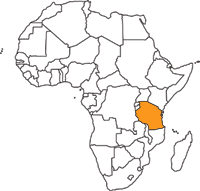Protected Areas in the United Republic of Tanzania
Tanzania has a great potential for natural resources, cultural and tourism attractions. In terms of wildlife, the present network of wildlife Protected Areas (PAs) in Tanzania is comprised of 15 National Parks, Ngorongoro Conservation Area, 33 Game Reserves and 43 Game Controlled Areas. The wildlife PAs network covers 233,300 Sq. Km (28%) of the total Tanzania's land surface area.
Wildlife Division, the leading light in the management of Tanzania's wildlife resources and their associated habitats for their sustained and equitable use, for the benefit, welfare and enjoyment of the generations of citizens of Tanzania and the world heritage at large.
The Role of the National Parks
The primary role of Tanzania national parks is conservation. The 15 national parks, many of which form the core of a much larger protected ecosystem, have been set aside to preserve the country's rich natural heritage, and to provide secure breeding grounds where its fauna and flora can thrive, safe from the conflicting interests of a growing human population.
The existing park system protects a number of internationally recognized bastions of biodiversity and World Heritage sites, thereby redressing the balance for those areas of the country affected by deforestation, agriculture and urbanization. The establishment of Saadani and Kitulo National Parks in 2002 expanded this network to include coastal and mountain habitats formerly accorded a lower level of protection.
Tanzania National Parks (TANAPA) is also currently acquiring further land to expand certain parks, and to raise the status of traditional migration corridors connecting protected areas.
In spite of population pressures, Tanzania has dedicated more than 46,348.9 square kilometres to national parks. Including other reserves, conservation areas and marine parks, Tanzania has accorded some form of formal protection to more than one-third of its territory – a far higher proportion than most of the world's wealthier nations.
Moreover, there are four Wetlands of International Importance (RAMSAR):
three Biosphere Reserves recognized by UNESCO:
and a series of areas recognized as World Heritage Sites:
- Kilimanjaro National Park
- Ngorongoro Conservation Area
- Ruins of Kilwa Kisiwani and Ruins of Songo Mnara
- Selous Game Reserve
- Serengeti National Park
- The Stone Town of Zanzibar
Source: The Official Website of Tanzania National Parks, Ministry of Natural Resources and Tourism
|


